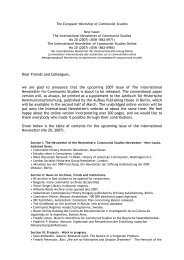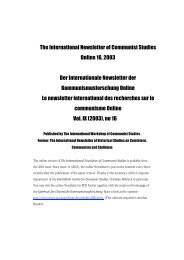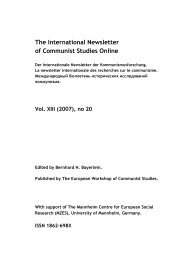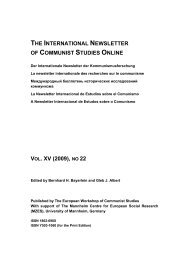VOL. XVI (2010), NO 23 - The International Newsletter of Communist ...
VOL. XVI (2010), NO 23 - The International Newsletter of Communist ...
VOL. XVI (2010), NO 23 - The International Newsletter of Communist ...
Sie wollen auch ein ePaper? Erhöhen Sie die Reichweite Ihrer Titel.
YUMPU macht aus Druck-PDFs automatisch weboptimierte ePaper, die Google liebt.
<strong>The</strong> <strong>International</strong> <strong>Newsletter</strong> <strong>of</strong> <strong>Communist</strong> Studies Online <strong>XVI</strong> (<strong>2010</strong>), no. <strong>23</strong> 145<br />
Helmut Peters: Die Volksrepublik China. Aus dem Mittelalter zum Sozialismus.<br />
Auf der Suche nach der Furt, Essen, Neue-Impulse-Verlag, 2009. 580 p. ISBN<br />
978-3-910080-71-3.<br />
Reviewed by Sobhanlal Datta Gupta, Calcutta<br />
This is an ambitious book, written by Helmut Peters, a distinguished Sinologist from the<br />
former GDR. That the author is a Marxist but not a doctrinaire in his orientation emerges<br />
quite clearly from the study. This is a work which constitutes a historical narrative as well as<br />
a theoretical interpretation <strong>of</strong> how China, an ancient Asian civilization, has made its<br />
fascinating journey from the Middle Ages to socialism, following its transformation into a<br />
People’s Republic through the revolution <strong>of</strong> 1949. Divided into four sections, the first section<br />
addresses the important issue relating to the Marxist debate on the characterization <strong>of</strong><br />
Chinese society under feudalism. This discussion is crucial, since it is this understanding<br />
which shaped the <strong>Communist</strong> Party <strong>of</strong> China (CPC)’s perception <strong>of</strong> the strategy and tactics<br />
<strong>of</strong> revolution before and after 1949. <strong>The</strong> second section examines how the concept <strong>of</strong> “New<br />
Democracy” was developed and practised by Mao Zedong in the period before the<br />
Revolution and until 1953. <strong>The</strong> third section focuses on the period 1953-1978, the most<br />
controversial phase <strong>of</strong> Mao involving the “Leap towards Communism” and the so-called<br />
Cultural Revolution. <strong>The</strong> fourth section is equally debatable, which concerns the post-Mao<br />
phase, associated with the Deng and the post-Deng view <strong>of</strong> how the CPC developed a new<br />
understanding <strong>of</strong> China’s advance towards socialism and how it differed from Mao’s position.<br />
In the first section the author touches upon some <strong>of</strong> the interpretations generated recently by<br />
central Party institutions under the auspices <strong>of</strong> the CPC. One such position is: China’s<br />
conditions <strong>of</strong> backwardness demanded first the accomplishment <strong>of</strong> a bourgeois-democratic<br />
revolution by putting an end to semi-feudalism. Another position states that the stage <strong>of</strong><br />
China’s economic development suggested that the country occupied an intermediate position<br />
between late feudalism and the first stage <strong>of</strong> entry into communism. A third position argues<br />
that it was the negative side <strong>of</strong> China’s traditional culture which explains many <strong>of</strong> the<br />
weaknesses <strong>of</strong> Mao’s ideas, i.e., a vulgarised and oversimplified understanding <strong>of</strong> Marxism<br />
(pp. 42-45). In his estimation <strong>of</strong> the concept <strong>of</strong> New Democracy, which was certainly a<br />
contribution <strong>of</strong> Mao, the author observes that the basic understanding which went into its<br />
making was that in conditions <strong>of</strong> China’s backwardness without completion <strong>of</strong> the bourgeoisdemocratic<br />
revolution, which involved a long process, socialist revolution was an<br />
impossibility. But the project <strong>of</strong> New Democracy, as an unavoidable and independent phase<br />
<strong>of</strong> social development in China, was cut short and remained incomplete, as the impression<br />
gained ground within the CPC shortly after 1949 that the transition to socialism had been<br />
realized and that China would now be heading towards communism. This explains the leftadventurist<br />
path <strong>of</strong> the CPC, associated with the “Cultural Revolution”, spearheaded by Mao.<br />
However, the “ultraleftism” <strong>of</strong> Mao is attributed by the author to the influence <strong>of</strong> Moscow’s<br />
and thereby Stalin’s understanding <strong>of</strong> Marxism, which was quite different from the position <strong>of</strong><br />
Lenin. This explains his accent on “the class struggle between the proletariat and the<br />
bourgeoisie” under socialism. Thus, Mao’s theoretical position was essentially voluntarist,<br />
focusing on will, which led him to develop an understanding <strong>of</strong> socialism that was grounded<br />
in politics but which was unrelated to the realities <strong>of</strong> society and economy <strong>of</strong> China, namely,<br />
her backwardness (pp. 252-253). As a consequence, shortly after 1949 he developed the<br />
illusory understanding that China was ready for a “Great Leap Forward” towards<br />
communism, oblivious <strong>of</strong> the fact that China had to traverse a long and tortuous road to<br />
socialism and that this backwardness could not be overcome by any voluntarist philosophy.<br />
As this understanding gained ground inside the CPC and as, after 1949, the Soviet model














